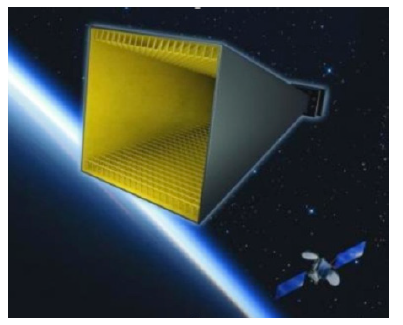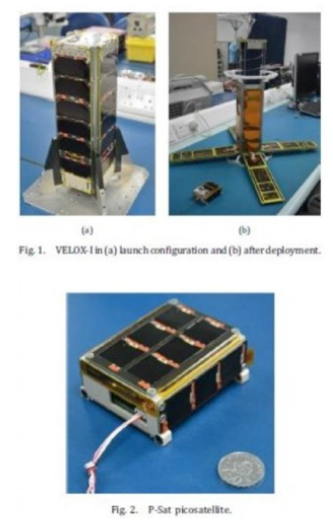- Submissions

Full Text
Academic Journal of Engineering Studies
Advanced Satellite Communications
Manu Mitra
Alumnus of University of Bridgeport, USA
*Corresponding author:Manu Mitra, Alumnus of University of Bridgeport, USA
Submission: June 07, 2019;Published: January 16, 2020
.jpg)
ISSN:2694-4421 Volume1 Issue1
Abstract
Applications of satellite communications has broader usage; for instance, voice, video calling, internet, fax, television, and radio communications. There are abundant and various types of satellites that has applications from amplification of radio telecommunications to military applications and most importantly its application is globally, and it also allows transmission of high amount of data.
In this paper various types of advanced satellites are discussed; some of them are quantum communication through satellites, metamaterials for better satellite antennas, National Aeronautics and Space Administration’s (NASA) laser communications, ZigBee based inter-satellite communications, quantum encryption network through satellite.
Keyword: Satellite; Advanced satellite; Quantum; Communications systems
Introduction
Satellites are relay stations in space for communication of video, voice and data transmissions. These are ideally designed to meet the global communication necessity of government, military and commercial organizations; one of the reasons because they are scalable, economical and very reliable transmission services that can easily reach multiple areas over vast geographic sites. Transmissions using satellite communications systems can bypass the existing ground-based infrastructure; often limited and unreliable in many parts of the world. Satellite communications consists of four major steps: An uplink Earth Station or any other ground transmitter to transmits the required signal to the satellite, Satellite amplifies the incoming signal and changes the frequency, Satellite transmits the signal back to Earth and the ground communication system receives the signal [1].
Quantum satellite communications
Canadian Scientists in collaboration with other team have taken a major step towards enabling secure quantum communications using moving satellites. It demonstrates the first quantum key distribution transmissions from ground transmitter to quantum freight on a moving aircraft system. To confirm the test were valuable proof of model for the satellite mission, the team in collaboration with Institute for Quantum Computing (IQC) and Department of physics and Astronomy at University of Waterloo, designed prototype receiver that consists of components compatible with the size and operating environment of a quantum satellite.
To validate their system, they used Twin Otter aircraft of National Research Council to carry out 14 passes over ground transmitting station at different distances, accomplishing a quantum signal link for seven passes and a secret key extraction for six of seven successful attempts [2,3].
Metamaterials for better satellite antennas
As per engineers from Penn State and Lockheed Martin Corp; economical, lighter and more energy efficient broadband devices on communication satellites is possible using metamaterials to alter horn antennas. Light weight antennas cost less to boost energyefficient antennas into space that can reduce size of storage batteries and solar cells which in turn reduces mass. Metamaterials due to their unusual properties from structure rather than composition and possess exotic properties are usually not found in nature. These metamaterials are designed specifically for electromagnetic waves to avoid previous confinements of narrow bandwidth and high intrinsic material loss, which results in signal loss.
This project was not to design theoretical metamaterial enhanced antennas but to build actual working prototype model. Ku band 12 to 18 gigahertz antennas require small structural intervals that are easily manufactured using super extended C-band 3.4 to 6.725 gigahertz that can be accomplished with simple wire grid structure that can be easily manufactured with an interval of about a quarter of an inch wires. Scientists took this method to convert the C-band application into a prototype. As per Douglas H. Werner, this is one of the first practical application of electromagnetic metamaterials that makes a real-world device better [4,5].
Nasa’s laser communication systems
Figure 1:Illustrates a 3-D rendering of a metamaterial-lined feed horn antenna with low loss, low weight and over an octave bandwidth for satellite communications shown with satellite. Image Credit: Penn State [5].

Figure 2:Illustrates Lunar Laser Communication Demonstration (LLCD) components integrated onto the Lunar Atmosphere and Dust Environment Explorer (LADEE) spacecraft. Image Credit: NASA/Goddard Space Flight Center [6].

National Aeronautical and Space Administration’s (NASA) first high rate data transfer using laser communication system was incorporated to the Lunar Atmosphere and Dust Environment Explorer (LADEE) spacecraft at NASA’s Ames Research Center, in California. Lunar Laser Communication Demonstration (LLCD) will exhibit laser communications from lunar orbit to Earth at six times the rate of best advanced radio communication system of modern day. LLCD system will be using advanced and highly reliable infrared laser like that were used for high speed data over fiber optic cables into the workplaces and homes. In this, data is sent in the form of hundreds of millions of short pulses of light every second.
The real task of LLCD would be to point its very narrow laser beam accurately ground stations across the distance of approximately 238,900 miles while moving. Failure would result in dropped signal or loss of communication. LLCD will also function as pathfinder. It will also evaluate the long-term viability of laser communication from geostationary relay satellite to Earth. Scientist consider that space operations would be able to use laser communication technology in future because of its low mass and power necessities to provide increased data quantity for real time communication and 3-D high definition video. For instance, using S-band communications aboard the LADEE spacecraft would take 639 hours to download an average length HD movie. But using LLCD technology that time would be significantly reduced to less than eight minutes [6].
Figure 3:Illustrates VELOX-I before and after deployment and a picosatellite. Image Credit: Shuanglong Xie, Guo Xiong Lee, Kay-Soon Low, Erry Gunawan, 2014 [8]

Figure 4:Illustrates from the ground, researchers measured laser signals that originated from a satellite and traveled through Earth’s gravitational potential and the turbulent atmosphere. The successful characterization of quantum features under such conditions is a precondition for the implementation of a global quantum communication network using satellites that would link metropolitan area quantum networks on the ground. Image Credit: Picture of the Earth: Google, picture of the satellite: ESA [10]

Zigbee based inter-satellite communication systems
Satellite Research Centre at Nanyang Technological University in Singapore designed VELOX-I, which comprises of a nanosatellite weighing around 3.5 kg and a piggyback picosatellite weighing around 1.5 kg. These both mini satellites were designed with a ZigBee wireless network and used small sensor nodes that accomplishes tasks such as distributed computing, local sensing and data acquiring. It is designed to calculate the performance of Wireless Sensor Networks (WSNs). After conducting experimental tests that received signal strength indicator on the satellites radio frequency modules, a maximum range of 1 km was accomplished for inter-satellite communication and even longer communication range can be projected in free space because of absence of signal attenuation affected by fading and diffraction.
In addition to high performance in inter-satellite communication WSNs are also significantly suitable for intra-satellite communication. Engineers replaced internally wired connections with wireless links, a satellite’s mass can be reduced by as much as 10%. With the significant increasing in pressure of minimizing designing costs and maximizing risk diversification impose major constrains on satellite designs. Production of comprehensive and lightweight systems could benefit significantly from WSNs [7,8].
Quantum encryption network through satellite
Quantum encryption network through satellite based would provide a very secure method to encrypt data that is set over long distances. Designing such kind of system in five years is an extraordinary fast timeline since most of the satellite requires around at least 10 years of design and development. Every component from screws to computers must be tested and approved to work in tough environmental conditions of space and continue to survive the gravitational changes experienced during the launch.
The impending security threat has got more attention on
implementing stronger encryption techniques, for instance
quantum key distribution. Instead depending on math, quantum
key distribution uses properties of light particles known as
quantum states to encode and send the key required to decrypt
the encoded information. If someone tries to measure the light
particles to steal the key, it changes the particle’s behavior in
such a way that alerts the communicating parties that key has
been compromised and cannot be used. As a matter of fact, this
system detects eavesdropping, that means secure communication
is assured. However, techniques for quantum encryption has
been in research and development for more than 10 years, they
don’t work over long distances because of residual light losses in
optical fibers that are used for telecommunications networks on
the ground degrade the sensitive quantum signals. New research
has demonstrated that quantum communication satellite networks
do not need to be designed from scratch, Marquardt notes that it
will take around 5 to 10 years to convert ground-based systems to
quantum-based encryption to communicate quantum states with
the satellites [9,10].
Acknowledgment
Author would like to thank Prof. Navarun Gupta, Prof. Hassan Bajwa, Prof. Linfeng Zhang and Prof. Hmurcik for their academic support. Author also thanks anonymous reviewers for their comments.
References
- Intel Sat General (2019) A primer on using satellites for communications.
- Christopher JP, Sarah Kaiser, Jean PB, Jeongwan J, Nigar S, et al. (2017) Airborne demonstration of a quantum key distribution receiver payload. Quantum Science and Technology 2(2): 024009.
- IOP Publishing (2017) Viability of quantum satellite communications. Science Daily.
- Erik Lier, Douglas HW, Clinton PS, Qi Wu, Jeremy AB (2011) An octave-bandwidth negligible-loss radiofrequency metamaterial. Nature Materials 10: 216-222.
- Penn State (2011) Metamaterials approach makes better satellite antennas. Science Daily.
- NASA/Goddard Space Flight Center (2013) NASA's first laser communication system integrated, ready for launch. Science Daily.
- Shuanglong X, Guo Xiong L, Kay SL, Erry G (2014) Wireless Sensor Network for Satellite Applications: A Survey and Case Study. Unmanned Systems 02(03): 261-277.
- World Scientific. (2014, August 25). World's first ZigBee-based inter-satellite comms system. Science Daily.
- Günthner, I Khan, D Elser, B Stiller, O Bayraktar, et al. (2017) Quantum-limited measurements of optical signals from a geostationary satellite. Optica 4(6): 611.
- The Optical Society (2017) Shortcut to satellite-based quantum encryption network: Precise Earth-based measurements of optical signals from satellite show that equipment already in space can be adapted for extremely secure data encryption. Science Daily.
© 2020 Manu Mitra. This is an open access article distributed under the terms of the Creative Commons Attribution License , which permits unrestricted use, distribution, and build upon your work non-commercially.
 a Creative Commons Attribution 4.0 International License. Based on a work at www.crimsonpublishers.com.
Best viewed in
a Creative Commons Attribution 4.0 International License. Based on a work at www.crimsonpublishers.com.
Best viewed in 







.jpg)






























 Editorial Board Registrations
Editorial Board Registrations Submit your Article
Submit your Article Refer a Friend
Refer a Friend Advertise With Us
Advertise With Us
.jpg)






.jpg)














.bmp)
.jpg)
.png)
.jpg)










.jpg)






.png)

.png)



.png)






